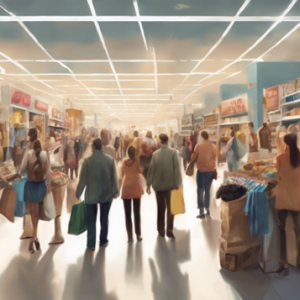Understanding the Importance of Customer Loyalty Programs
Loyalty programs should be essential to your business strategy. Not only do they retain existing customers, but they also attract new ones. According to Forrester research, 73% of companies list customer retention as their top priority for the following year.
Considering how pivotal customer engagement is to any modern business, it makes sense that more innovative strategies will appear in 2024.
In 2024, its anticipated that several new loyalty program trends will evolve. There will be an upsurge in gamification within loyalty programs, increasing user engagement. Another prediction is the widespread implementation of personalized rewards catering to individuals’ preferences. Consumer-generated content will play a more prominent role, forming more participative loyalty programs.
Innovative Trends in the Customer Loyalty Program Landscape
We’re seeing several pioneering trends shaping customer loyalty programs in 2024.
Gamification
The most prominent is gamification, which promises to make rewards programs more engaging for customers. To lead with an example, Starbucks’ “Starland” game, introduced in 2023, allowed customers to win exciting rewards by participating in an immersive digital experience. Players download the app, register for the Starbucks Rewards program, then enter to win raffles. Once the players are in the game, they search the skies within the game to find golden stars. Each star is a raffle ticket. They choose the raffle they want to win, such as “free drinks for a year.” [1]
Combining gamification with brand rewards allows for creating unique experiences that connect with customers.
Mobile Technology
Mobile technology is another trend that has a significant impact. The rise of mobile wallet loyalty cards in 2023 has been apparent. Retail giants like Walmart have integrated their loyalty programs into mobile wallets, making the collection and redemption of rewards seamlessly easy for mobile-savvy consumers.
Personalization
Customers increasingly expect offers and rewards tailored to their preferences and behaviors. In response, retailers are leveraging big data and AI to provide hyper-personalized deals.
Sephora, for example, maximized its Beauty Insider program by offering members personalized rewards based on their purchase history.
Incorporating Technology into Loyalty Programs
The integration of technology is reshaping traditional loyalty models and businesses can no longer ignore its power in customer loyalty programs.
In 2024, the rise of AI-powered loyalty programs will begin to manifest themselves in meaningful ways. AI has many applications. In data analytics, companies can use AI to predict customer behavior and tailor rewards accordingly. This precision can make automating rewards more relevant, driving higher engagement [2].
Augmented reality will also become a prominent feature in customer loyalty programs in 2024. Retailers and businesses will use AR to offer immersive shopping experiences, allowing customers to virtually “try before they buy” or explore virtual store setups. This technology will revolutionize how customers interact with products and services. Integrating AR in loyalty programs will bridge the gap between online and offline shopping, making it a crucial tool for businesses to differentiate themselves in a competitive market.
Incorporating technology is an essential consideration moving into 2024. However, a custom strategy for any brand before considering the technology-based opportunities is always the best approach.
Personalization Techniques for Effective Loyalty Programs
Consumers crave experiences tailored to their needs and interests. Businesses that answer this call create a unique connection with their customers.
In 2023, companies like Netflix and Birchbox got personal with customers. Their personalized rewards programs used purchase history and preferences to boost customer usage and retention. Let’s take a closer look at a case study from Birchbox.
Case Study: Birchbox
Birchbox, a company founded on personalization, takes user feedback to improve its recommendations, which adds a personal touch and satisfies unique customer expectations. The following techniques are examples of how Birchbox used personalization in its loyalty program design:
Personalized Beauty Boxes
- Birchbox’s core offering is its monthly subscription box, customized based on each customer’s beauty profile. When customers sign up, they complete a beauty profile questionnaire detailing their preferences, skin type, hair type and product interests. Birchbox uses this information to curate a personalized selection of beauty and grooming products in each customer’s monthly box.
Product Recommendations
- Birchbox’s website and app provide customized product recommendations based on customers’ past purchases, reviews and beauty profile data. This feature helps customers discover new products that align with their preferences and beauty goals.
Rewards Points
- Birchbox operates a rewards program where customers earn Birchbox Loyalty Points for various actions, such as making purchases, referring friends and reviewing products. These points are redeemed for discounts on future purchases. Personalization comes into play as the rewards program tailors point-earning opportunities based on individual customer behavior and preferences [3].
In 2024, companies are preparing to take personalization to the next level. Leveraging AI and machine learning, businesses can anticipate customer needs. Predictive analytics using vast data sets will drive personalization and exceed customer expectations in the new year.
The use of real-time data for personalization is expected to be a game-changer. It will serve customers with rewards programs that are relevant in the here and now. Together, these trends promise to mold the future of loyalty programs [4].
How Omnichannel Approaches are Revolutionizing Loyalty Programs
Most brands have adopted omnichannel approaches these days to meet their customers when, where and how they want. Sephora, with its successful ‘Beauty Insider’ loyalty program, uses an omnichannel approach, assisting customers both online and in physical stores.
This approach is seamless between all channels. The customer’s journey continues uninterrupted, whether they are shopping in-store, online, or through mobile applications. This improves the customer experience and increases purchase rates.
There will be more advancements in omnichannel loyalty programs. These technologies will become commonplace, enhancing the accuracy and effectiveness of omnichannel loyalty strategies.
Summary: Future Prospects and Growth of Loyalty Programs
We expect loyalty programs to continue to surge in 2024. Automation and personalization will largely drive this growth. Enhanced customer experience remains integral to this evolution.
Loyalty programs will integrate more advanced technology, including AI and predictive analytics. These technologies will inform the development of more strategic and effective loyalty programs.
More emphasis will be placed on multi-channel customer engagement. Seamless integrations of online and offline experiences are essential to customers; loyalty programs must follow suit.
More loyalty programs will offer experiential rewards to cater to customers’ unique preferences and behaviors.
We foresee a landscape that is more technologically advanced and customer-centric. Stay tuned to see how these developments play out.
References:
[1] Zinck, B. (2023). Gamification in Loyalty Programs: Starbucks’ “Starland” Case Study. Loyalty360. https://loyalty360.org/content-gallery/daily-news/restaurant-brands-offer-loyal-customers-rewards-fo.
[2] “Loyalty Programs: Trends & Innovations”. Deloitte, 2020. https://www2.deloitte.com/us/en/pages/consulting/articles/consumer-loyalty-programs-and-expectations.html
[3] BirchBox Membership https://www.birchbox.com/membership
[4] “How to Win Customer Loyalty in the Age of AI,” 2023, https://www.lbbonline.com/news/how-to-win-customer-loyalty-in-the-age-of-ai.















